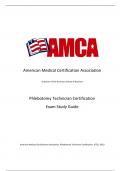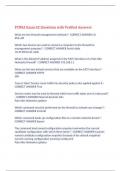American Medical Certification Association
‐A division of the American School of Business‐
Phlebotomy Technician Certification
Exam Study Guide
American Medical Certification Association, Phlebotomy Technician Certification, (PTC), 2010
,Dear Student,
This exam prep study guide is intended to be used as reinforcement for what you have already
learned. It is not intended to replace classroom learning or notes that you have already taken.
Instead, use what you have already learned, and the notes that you have taken and the books
that you used could be a great reference while you are studying.
The exam consists of 100 multiple choice questions and you will have two hours in which to
complete the exam. When taking the test, always apply these test taking strategies:
• Look for distracters in the question such as the words, not, always, exactly, first, next,
etc.
• Read all the answers
• Eliminate the ones that you know are incorrect
• Narrow it down to 2 possible answers
• Choose the BEST possible answer
ON TEST DAY
1. Please bring a picture ID with you. A valid driver’s license, county ID, and passport are
all acceptable forms of ID.
2. Please bring a #2 pencil with you.
3. Fill out all registration and test answer sheets in their entirety. Your full name as you
would like it to appear on your certification card, your complete SSN and mailing
address are necessary. Failure to provide this information, will delay the processing of
your exam.
4. DO NOT WRITE IN THE TEST BOOKLET! All of your answers must be recorded on
the answer sheet.
5. Cheating of any kind will not be tolerated. If someone is suspected of cheating, they will
be removed from the classroom. They will forfeit their right to retake the exam.
6. In order to be successful on the exam, you must achieve a 70% or better on the exam.
7. Once the exam begins, you will not be allowed to access your cell phone or any other
electronic device. Please turn them to silent prior to entering the classroom.
8. Once the exam begins, you will not be allowed to use the restroom. Please use the
restroom before the exam begins.
American Medical Certification Association, Phlebotomy Technician Certification, (PTC), 2010
, Special Accommodations
AMCA and the American School of Business pledge to comply with the provisions of the
Americans with Disabilities Act. as amended (42 USCG Section 12101, et. seq.), and with Title
VII of the Civil Rights Act, as amended (42 U.S.C. 2000e, et seq.), to the best of their ability.
If you need special accommodations because of a disabling condition, you may ask for special
testing services. This request must be submitted in writing and included with your registration.
All requests are handled on an individual basis.
If you are requesting special accommodations you must submit a letter (IEP) from an
appropriate healthcare professional that is licensed to evaluate the disability. The letter must be
written on the healthcare professional’s letterhead and include the professional’s title, address
and telephone number and date. The letter must also include a diagnosis of the disabling
condition and explain why special testing accommodations are necessary. The letter must have
an original signature from the professional and be dated no more than 2 years prior to
registration of the exam
Exam Challenges
If you have a question or believe any part of the exam was unfair or misleading, you can email
customer service and your concerns will be forwarded to the appropriate department. When
emailing, please include “Exam Challenge” in the subject line and email to:
AMCA@AmericanMedicalCertification.com.
Good luck on your exam!
American Medical Certification Association, Phlebotomy Technician Certification, (PTC), 2010
, AMCA National Phlebotomy Review
The History of Phlebotomy
Hippocrates (the father of modern medicine) thought that disease was excess fluid in the body.
Bloodletting became a common practice in his time. Barber surgeons were allowed to do certain
practices such as bloodletting, leaching, cupping, shaving and enemas. The Greek term for phlebotomy
literally translates into phlebos, meaning vein, and tome, meaning an incision.
Phlebotomy Today
Phlebotomy is now practiced to:
‐Obtain blood for patient monitoring, and diagnostic purposes
‐ Remove blood from patients for blood banking and transfusion purposes
‐Remove blood for therapeutic purposes
‐Venipuncture procedures
‐Capillary punctures
Job Settings for Phlebotomist
1.) Hospital (Inpatient ) Settings
A.) Acute‐care hospitals
B.) Specialty hospitals
C.) Urban or rural hospitals
D.) Hospital‐based clinics
E.) Hospital‐ based emergency centers
2.) Ambulatory Care (Outpatient) Settings
A.) Health department clinics
B.) Community health centers
C.) Community‐based mental health centers
American Medical Certification Association, Phlebotomy Technician Certification, (PTC), 2010







